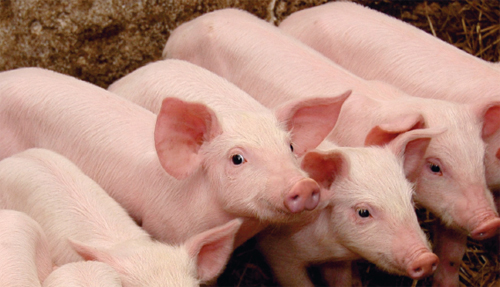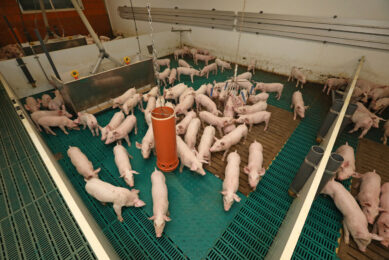Practical use of blood plasma in piglet feeding

The BSE crisis has banned the use of animal products in animal feeds. It is not well-known, however, that blood plasma is allowed again and that it is beneficial to the health of piglets. Blood plasma may be used when a feed mill has divided production lines for ruminants and monogastrics to avoid cross contamination. Several speakers addressed the topic during a mini-seminar, held at EuroTier in Hanover, Germany, in November last year.
Blood plasma, as the name indicates, is derived from blood of other pigs. This is usually extracted from blood straight after slaughter and can be divided into three components: lymphocytes and platelets (less than 1%), red blood cells or erythrocytes (45%), and plasma (55%). The plasma, in turn, consists for 92% of water and 2-9% of proteins. These proteins consist for 36% of globulins, of major importance for living creatures as they help increase their resistance against pathogens. Hence blood plasma can be described as a highly concentrated and healthy source of proteins.
In Hanover, Dr Jannes Doppenberg, Schothorst Feed Research, painted the current picture on the use of antibiotics in animal feeds and the pressure in the Netherlands in specific to completely ban medicated feeds from the feed mill. In the Netherlands some 10% of the feed is medicated.
According to Nevedi, the Dutch feed manufacturers organisation, there is a 5.6% carry-over of antibiotics from medicated feeds to normal feeds. Medicated feeds are trouble in the feed mill and costs are high to comply with GMP and HACCP rules in running flush batches after a medicated batch has been produced. Carry-over in feed can also be a threat in causing antibiotic resistance in microbes due to constant exposure to very small quantities of drugs. “There are plenty of alternatives to administer antibiotics to the animals, especially via the drinking water,” Doppenberg said.In the Netherlands, usage of antibiotics in feed is twice as high than in France, Germany and the UK, Doppenberg revealed. No figures are available for the countries in southern Europe, but it is expected that antibiotic resistance in these countries is higher than in northern Europe.
The Dutch Ministry of Agriculture set targets to further reduce antibiotic usage in farm animals.
In comparison to 2009, a 20% reduction in usage by producers has to be achieved in 2011 – and 50% has to be met in 2013. In addition, Nevedi strives for completely ceasing the production of medicated feeds in 2011. For the time being the initiatives stand alone, since there is no European consensus to reduce antibiotic usage in animal production through legislation.
Increased usage in pigs is probably related to the improvements in litter size, as the average number of piglets has grown but the total birth weight is identical as in the past – hence the average piglet weight is lower. This way, piglets are more susceptible for disease challenge.
Reduction of antibiotic usage
When antibiotic usage needs to be reduced, management at farms has to be brought up to a higher level. More attention and perhaps radical changes have to be made in sow management, creep feeding, weaning time, barn climate, farm hygiene, and water quality. Gut health can also be improved through the addition of feed additives (organic acids, medium chain fatty acids, essential oils, enzymes, pro-/prebiotics, MOS, ZnO), and via feed processing by paying more attention to particle size, pelleting and/or expanding piglets feeds.
Furthermore formulation can also help to improve gut health of piglets. Figure 1 shows the impact of antibiotics on gut health. Antibiotics among others decrease the transformation of bile salts and as such increase absorption of fats. In antibiotic-free feed more attention needs to be paid to fats which are highly digestible, e.g. palm oil. Reduction of fermentable carbohydrates content leads to more non-starch polysaccharides (NSP) in the large intestine. Here these are fermented to short chain fatty acids, which in turn are an energy source. Concerning protein it is advised to reduce crude protein and indigestible protein content (i.e. synthetic amino acids) and use highly digestible protein sources (i.e. animal proteins, processed plant proteins). However, distillers dried grains and solubles (DDGS) are a poor protein source for piglets due to its difficult to digest protein content.Other undesired items in a piglet feed are substances that decrease feed intake (e.g. mycotoxins) but rather use feedstuffs that improve feed intake (fish meal, plasma, sugars).
Decrease buffering capacity of feed in conjunction with organic acids (i.e. limestone) and consider using functional proteins (IgG sources) and carbohydrates (lactose).Doppenberg concluded that antibiotic usage and consequently antibiotic resistance in animal production is a public concern and that its usage shows presently no sign of declining despite improved management practices. Doppenberg said, “Antibiotic use in piglets is reducing, but usage in weaners and fatteners is increasing. Plasma is a viable functional protein to increase feed intake and improve gut health.”
Blood plasma
How spray dried plasma (SDP) works was explained by Dr David Torrallardona of research institute IRTA at Mas de Bover, Constantí, Spain. SDP is obtained from blood. About 55% of the blood is plasma, the remaining parts being erythrocytes (45%) and lymphocytes and platelets (<1%). Plasma constitutes for about 92% of water and 6-9% proteins. These proteins are made up of albumen (60%), globulins (36%) and fibrinogens (4%). Torrallardona analysed 43 publications covering 75 trials with 12,000 piglets fed SDP in the diet.
“In terms of preference, SDP had intermediate values. Fish meal is more preferred and also dried skimmed milk has more preference. But when looking at chewing efforts of diets with different protein sources SDP is clearly easier to eat for piglets,” Torrallardona said. In terms of FCR he found that challenged piglets have a better FCR than unchallenged, which seems to be related to the immunoresponse of the piglets, since immunoglobulins take up 18% of the plasma. “With plasma E. coli does not attach to the brush border of cells and thus cannot colonise the intestinal wall,” he explained. As SDP lowers E. coli infection, the shedding of the bacteria is decreased to a level where the risk of a clinical outbreak is minimised. Torrallardona concluded that SDP enhances piglet growth.The mode of action is Ig-fraction related, but many other bioactive components are also present.” Furthermore from the studies it was concluded that SDP:
• Has a direct action on pathogens in gut lumen (antimicrobial, binding, toxin neutralisation).
• Has an immunomodulatory effect. Reduces response →higher nutrient availability.
• Causes modulation of inflammatory response →reduced cytokines.
• Reduces tissue damage → better gut integrity → better absorption.
SDP in practice
The positive effects on productivity obtained by adding blood plasma to feed mixtures for piglets have been shown in many studies worldwide. Dr Gerhard Stalljohann, head of the Pig Unit at Agriculture Centre Haus Düsse, Germany presented some results of trials that were done at the institute. “As of 1 September 2005, use of blood plasma in pig feed is permitted again in Germany. Blood plasma in the ‘first’ piglet feed increased feed intake and performance. Many other trials show performance-enhancing effects,” he said.
To illustrate the productivity improvement for pig farmers in north western Germany, two studies with blood plasma in piglet feed were carried out at Haus Düsse. In the first study (in 2000) piglet feed contained 8% blood plasma in the experimental group and 9% potato protein in the control group in week 1 and 2. In week 3, 4 and 5, blood plasma was reduced to 3% and the potato protein to 4%. During the last period, from the sixth week on, the piglets in both groups received the same feed.Compared to the potato protein, the blood plasma resulted in a significant productivity increase of 4.4% in the seven-week rearing period and an increase of 7.3% in the six-week rearing period. The need for continuing the addition of blood plasma to the feed was questioned, since the resulting high feed costs deduct too much from the profitability of such a rearing method.
Therefore, following the re-admittance of blood plasma in Germany starting as of September 2005, a second study was done with piglets using feed containing 3.5% to 7.0% blood plasma for the first piglet starter feed only. For the control group, whey protein concentrate was used in the same proportions. The results of this experiment are shown in Table 1. Due to a sustained increase in feed intake, the weight of piglets increased by 0.85 kg and 1.06 kg, respectively, by the end of the rearing period. Such an increase tends to result in more profitable piglet rearing by about €0.45.
Feeding recommendations
Alberto Morillo, director of consultancy company Test&Trials in Spain and adviser to many pig production companies surveyed several trials with SDP in weaning diets in Europe. From these trials he concluded that traditional plasma inclusion rates (5%) improve nursery performance throughout the nursery phase and lower inclusions (2.5%) results in a ‘loss’ of the plasma effect. Plasma also outperformed nucleotides (peptides obtained from yeast), which showed no significant improvement compared to the control diet. The same conclusion could be drawn from a trial where SDP was compared to defatted egg yolk powder.
Morillo said, “In five trials at a commercial Danish nursery farm SDP was used compared to a control without plasma and SDP improved average daily gain by 26 g and lowered FCR by one point over a two week period.” From research results and his practical experience, Morillo composed feeding recommendations for inclusion of SDP in the diet (Table 2). “Feeding programmes should be designed to minimise stress situations. It is important to remember that an effective dose of plasma is needed for various situations,” he said.He added, “What is also interesting, is the effect SDP inclusion has on the piglets’ behaviour. In a Brazilian university study it was found that piglets fed SDP in the diet showed remarkably less undesired behaviour such as biting and mounting. The piglets also used the feeder more and the drinker less than their counterparts without SDP in the diet. Skimmed milk powder also gave better results than the control diet, but to a lesser extent than with SDP in the feed. So in fact, piglets eat better, drink less and fight less when they are fed SDP.” PP
The seminar was organised by the European Animal Protein Association (EAPA).











